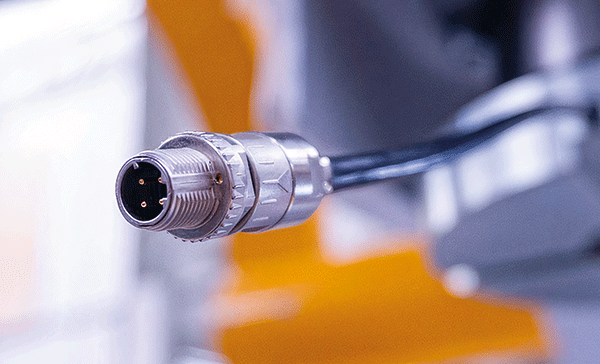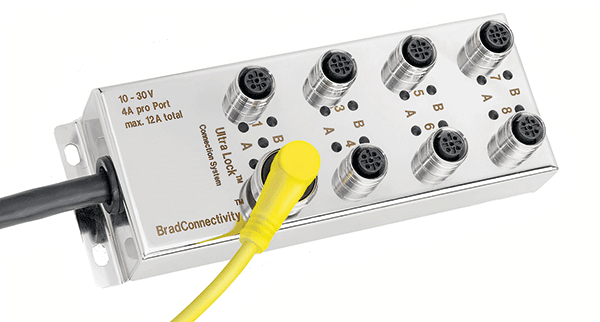
Many connector manufacturers have been talking about the industrial marketplace, and with the global market for industrial automation predicted to double over the next decade, connectivity will be an important subject.
The key driver of growth in the industrial automation market is the Industrial Internet of Things (IIoT) and its ultimate creation, the smart factory. While the Internet of Things has made the headlines over the last few years in the domestic market, it is in the industrial area that the true potential of IoT will be realised.

IoT is the name used to describe machine-to-machine communications. For the first time, machines are sharing data with each other without human intervention. This allows efficient sharing of critical information to create greater efficiency.
The factory, however, represents a harsh and demanding environment. Vibration, extreme temperatures and potentially harmful chemicals all conspire to play havoc with the sensors and controls that are a vital part of the smart factory. Even industries that depend upon hygiene, such as food preparation or pharmaceuticals, rely on the ability to clean processing equipment. In these conditions, harsh chemicals are replaced by cleaning materials and the use of high-pressure water jets.
The constellation of sensors that the smart factory employs, along with more sophisticated communication equipment, will mean that the number of connections required will rise significantly. With such a high number of channels to be connected, the days of hardwired cables and centralised control cabinets are in the past. The modern factory will use a far more modular approach, with OT devices connected locally using I/O blocks, which will then be linked to the network. The connector technology, however, is not set to change much, with tried and tested connectors being used.
There are logical reasons for employing established products when it comes to connectivity. The first reason is reliability. Manufacturers cannot afford for the new factories to grind to a halt simply because a connector has failed. Therefore, there is considerable value in choosing connectors that have a proven track record after years of service in harsh conditions.
There is also a significant financial consideration. Very few companies have the luxury of scrapping all its machinery just to take advantage of new innovations. Therefore, the chances are high that the latest technology will be integrated into an existing installation. If the new devices use the same connectivity as existing equipment, the installation, supply and integration will be considerably simpler.
For many years, the M-series of circular connectors have been a popular choice for industrial connectivity. Using metric threads, the M-series is designated by its diameter from M5 to M23 and beyond. The M8 and M12 versions are amongst the most popular, as they are lightweight, slim in profile and can be easily made waterproof. They are available from a wide range of manufacturers. Some, such as Phoenix Contact, Lumberg and HARTING are specialists in industrial connectivity, while others, including TE Connectivity, offers them as part of its larger connector portfolio.

As the industrial world incorporates increasingly more information technology, connectors that are familiar from the IT world are also finding their way into factory environments. Instantly recognisable solutions such as the RJ45 and USB connectors are not always the best solution for service on the factory floor. Several manufacturers have developed solutions that embed these common interfaces into robust housings that are more suited for harsh conditions, like the Bulgin Buccaneer range.
There are also new connector technologies being developed which are suitable for the new IIoT communication requirements. Single Pair Ethernet (SPE) is one such innovation. SPE, however, is not intended to replace the existing Ethernet infrastructure, whether it uses RJ45 or M12 connectors. Rather, SPE has been designed to complement it and carry Ethernet to the factory floor.
Manufacturers are also innovating with existing products. It has already been stated that M-series connectors are highly popular in industrial applications, but even these can be improved. M-series connectors often rely on a screw-locking process to ensure robust and reliable mating. However, mating a screw-locking connector takes time. This may seem insignificant when installing a single product, but when faced with the array of connectors that will be required for a new machine, this time adds up. In addition, screw-locking connectors are not infallible. Installers may not fasten them with the correct amount of force, leaving them vulnerable to water ingress.
The new Brad Ultra-Lock family of M12 connectors from Molex employs a push-to-lock system that allows rapid installation. The push-fit functionality provides consistent mating that is sealed against the ingress of water, while at the same time speeding up installation.
The smart factory is a place for new and innovative technology, and while connectors might not be the most exciting components, the role they play is vital in the factory of the future.
| Email: | [email protected] |
| www: | www.trxe.com |
| Articles: | More information and articles about TRX Electronics |

© Technews Publishing (Pty) Ltd | All Rights Reserved